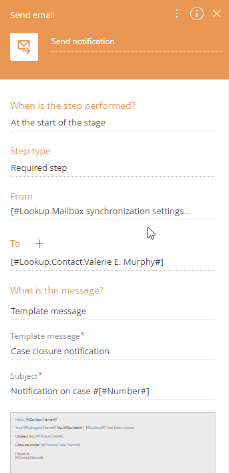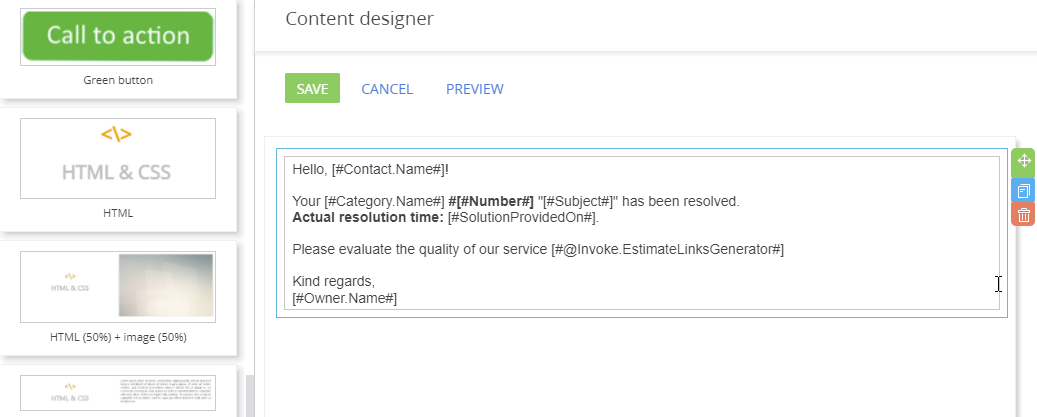The Send Email ![]() element is used for creating and sending new email messages automatically or manually during case execution. You can enter the email content directly when designing the process or select one of the pre-configured email templates.
element is used for creating and sending new email messages automatically or manually during case execution. You can enter the email content directly when designing the process or select one of the pre-configured email templates.
Set up the [Send email] element
Specify the email parameters in the element setup area (Fig. 1).

The name of the element is displayed at the top of the setup area. This makes the element easy to find on the case diagram.
Fill out the following fields:
- When is the step performed? – indicates whether the Change access rights element is activated at the start of the stage or upon completion of a specified case step. Select “At the start of the stage” if the email must be sent at the start of the case stage. Select “After the previous step is complete” if the email needs to be sent after the previous step in the case stage. Specify the step in the Perform after step field.
- Step type – specify if the step is required. Select “Required step” if the task needs to be completed to transition to the next stage. If sending an email is not required to perform the task to transition to the next stage, select “Optional step”.
- From – an email account integrated with Creatio and used for sending emails. You can specify the sender manually or map the value of this field to another case or case element parameter. If the email is sent automatically, this field is required. To do this, populate this field with a specific mailbox, select Select from lookup in the parameter value menu, then in the Synchronization with mailbox settings lookup, select one of the configured email accounts. If the email is sent manually, this field is optional: a process user may select the email account from the available list on the email page before sending.
-
To – Enter the recipient's email address (either an email address, a contact or an account). You may choose a specific account or map the field value using the parameter value window. If either a contact or an account is selected, the email address will be pulled from the Communication options detail. When entering email address directly, enclose it in quotation marks, for example, "johanson@gmail.com".
To set up an email case notification, select Contact → Process parameter in the parameter value menu. In the parameter selection window, choose one of the previous case steps, e. g., “Case processing”, and select the Contact parameter value. This is a required field.
If necessary, specify additional recipients, as well as carbon copy (cc) and/or hidden copy recipients (bcc). To do this, click the
 button in the To area, and select the necessary fields.
button in the To area, and select the necessary fields. - What is the message? – choose the email format type.
-
Custom message – an email created in the Content Designer during the element set up. It is possible to create a new email page for editing and sending emails manually during the process execution.
If you selected “Custom message”, enter the necessary message in the message area. Use the Content Designer to customize the message body, add images and process parameters to it (Fig. 2).
Fig. 2 Edit the email body in the Content Designer
-
Template message – an email with a pre-configured template (created in the Content Designer). The selection is made from the Email templates lookup.
If the template contains macros, populate the Record for macros field so that the template contains the values of the macros that correspond to the current case. For example, to send a case processing notification, specify the "Id" column of the main record in the Record for macros field.
-
- Record for macros – specify the record that will transfer macro values to the template. The field is displayed only if the macro source is specified in the selected email template.
- Subject – enter the subject of the email. This field is required for manual send outs. If you are using templates, this field is populated automatically.
- How is the message sent? – select the send out method:
-
Send email manually – a new email editing page will open for the user during business process execution. Select this option if the user must view and edit the email before sending it. If this value is selected, populate the following fields:
-
Who is the sender? – the user who is responsible for sending out this email. This is a required field. By default, the field is filled in with the “System variable” value. Current user contact”. If the email needs to be sent on behalf of the case owner, populate the field with the “Owner” column of the main record.
-
Show page automatically – select the checkbox if you want the email page to be shown to the user when the process item is executed. If the checkbox is cleared, a draft message will be created, which can be viewed in the draft messages list on the Business process tasks tab of the communication panel.
-
Email connections – the system will prompt you to connect the email to the object, used to create a case. You can associate an email with other system entities, e. g., to display this email on the Email detail of these entities. To do this, click
 and specify the connected object for an email. You can populate these fields using the parameter value window.
and specify the connected object for an email. You can populate these fields using the parameter value window.
-
- Send email automatically – a pre-configured email is sent automatically during case execution. Requires an address in the From field. Select this option if you need to send notifications and other automatic messages. If you selected an automatic email sending option, populate the following fields:
-
Importance – select the priority of the sent message. Used to categorize outbound emails. Used to categorize outbound emails.
-
Ignore email errors – select the checkbox to send email despite email-related errors. If there was an issue with sending an email, the business process will also end with an error.
-
-